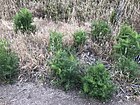Note: This is a project under development. The articles on this wiki are just being initiated and broadly incomplete. You can Help creating new pages.
Pimpinella anisum - Anisūna
Anisūna consists of dried fruit of Pimpinella anisum. It is an annual erect plant introduced and cultivated in India at Uttar Pradesh, Orissa and Punjab.
Contents
- 1 Uses
- 2 Parts Used
- 3 Chemical Composition
- 4 Common names
- 5 Properties
- 6 Habit
- 7 Identification
- 8 List of Ayurvedic medicine in which the herb is used
- 9 Where to get the saplings
- 10 Mode of Propagation
- 11 How to plant/cultivate
- 12 Commonly seen growing in areas
- 13 Photo Gallery
- 14 References
- 15 External Links
Uses
Asthma, Anisette, Catarrh, Bronchitis, Hiccough, Epilepsy, Colic, Flatulency.
Parts Used
Chemical Composition
It contains Volatile oil, fixed oils and protein.[1]
Common names
| Language | Common name |
|---|---|
| Kannada | |
| Hindi | Badiyan Rumee, Sauph |
| Malayalam | |
| Tamil | Shombu |
| Telugu | |
| Marathi | NA |
| Gujarathi | NA |
| Punjabi | NA |
| Kashmiri | NA |
| Sanskrit | Śvetapuṣpā |
| English | Anise |
Properties
Reference: Dravya - Substance, Rasa - Taste, Guna - Qualities, Veerya - Potency, Vipaka - Post-digesion effect, Karma - Pharmacological activity, Prabhava - Therepeutics.
Dravya
Rasa
Tikta, Kaṭu
Guna
Tīkṣṇa, Laghu
Veerya
Uṣṇa
Vipaka
Kaṭu
Karma
Kaphahara, Artavajanana, Vātānulomaka, Rakṣoghna
Prabhava
Habit
[[:Category:Habit - |]]
Identification
Leaf
| Kind | Shape | Feature |
|---|---|---|
| Paripinnate | Oblong | Leaf Arrangementis Alternate-spiral |
Flower
| Type | Size | Color and composition | Stamen | More information |
|---|---|---|---|---|
| Unisexual | 2-4cm long | Pink | Flowering throughout the year and In terminal and/or axillary pseudoracemes |
Fruit
| Type | Size | Mass | Appearance | Seeds | More information |
|---|---|---|---|---|---|
| Oblong pod | Thinly septate, pilose, wrinkled | Seeds upto 5 | Fruiting throughout the year |
Other features
List of Ayurvedic medicine in which the herb is used
Where to get the saplings
Mode of Propagation
[[:Category:Index of Plants which can be propagated by |]]
How to plant/cultivate
Sow the seed in dry, light soil, on a warm, sunny border, early in April, where the plants are to remain. When they come up, thin them and keep them clean from weeds. Allow about a foot each way. The seeds may also be sown in pots in heat and removed to a warm site in May.[3]
Commonly seen growing in areas
[[:Category:Herbs that are commonly seen in the region of |]], [[:Category:Herbs that are commonly seen in the region of |]].
Photo Gallery
References
- ↑ The Ayuredic Pharmacopoeia of India Part-1, Volume-5, Page no-17
- ↑ [Morphology]
- ↑ Cultivation detail
External Links
- Ayurvedic Herbs known to be helpful to treat Asthma
- Ayurvedic Herbs known to be helpful to treat Anisette
- Ayurvedic Herbs known to be helpful to treat Catarrh
- Ayurvedic Herbs known to be helpful to treat Bronchitis
- Ayurvedic Herbs known to be helpful to treat Hiccough
- Ayurvedic Herbs known to be helpful to treat Epilepsy
- Ayurvedic Herbs known to be helpful to treat Colic
- Ayurvedic Herbs known to be helpful to treat Flatulency
- Herbs with Seeds used in medicine
- Herbs with Fruits used in medicine
- Herbs with common name in Hindi
- Herbs with common name in Tamil
- Herbs with common name in Sanskrit
- Herbs with common name in English
- Habit -
- Index of Plants which can be propagated by
- Herbs that are commonly seen in the region of
- Herbs
- Repeat plant






